




© Stock.Adobe.com/au/DedMityay
IEC 61511 Functional Safety has gained acceptance across global industrial processing, mining and manufacturing sectors. At the heart of this standard are prescriptive guidelines revolving around Safety Instrumented Systems (SIS) that mitigate risks to protect personnel, facilities and the environment. Each SIS includes one or more Safety Instrumented Functions (SIFs) that help ensure safe operation. The logic solver, a crucial component of each SIF, determines when dangerous conditions exist and executes actions that mitigate unwanted or unsafe conditions. Currently, a large gap exists between simple and complex logic solvers — based on point/loop count, complexity requirements and cost. Low point-count logic solver requirements are often handled with single-loop logic solvers while more complex applications are tackled with larger and more costly safety PLCs.
In response to the demand for a more cost-effective and compact multiloop logic solver for plant-critical safety applications, Moore Industries has introduced the exida certified and SIL 2/3 capable SLA Multiloop and Multifunction Safety Logic Solver and Alarm. With up to 17 I/O channels, built-in voting and enhanced math and logic capabilities typically found in costly and complex safety PLCs, the SLA can handle everything from simple alarming to more complex logic schemes including 1oo2, 2oo3 or even 5oo8 voting architectures. This enables the SLA to act on hazardous or unwanted process conditions; provide emergency shutdown; or provide on/off control in Safety Instrumented Systems and traditional alarm trip applications. For more details on the SLA, visit www.miinet.com/sla or email sales@mooreind.com.au.



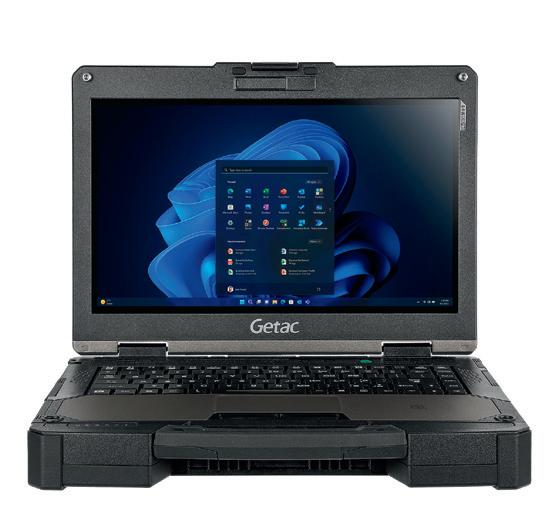
PROCESS TECHNOLOGY AUGUST/SEPTEMBER 2023 CONTENTS 0823 This issue is available to read and download at READ ONLINE! www.processonline.com.au/magazine 4 EtherCAT: leveraging industrial Ethernet for 20 years 14 In the driving seat: how users are shaping the future of the DCS 19 The ins and outs of I/O: local, remote and distributed 24 Light curtain or safety laser scanner? Choosing an optical safety device 34 How the IIoT can fast-track Australia’s sovereign manufacturing capability ON THE COVER
Moore Industries www.miinet.com
ETHERCAT: LEVERAGING INDUSTRIAL ETHERNET FOR 20 YEARS

4 PROCESS TECHNOLOGY - AUGUST/SEPTEMBER 2023 www.ProcessOnline.com.au
is the only industrial fieldbus that leverages Ethernet for both high speed and real-time performance.
EtherCAT
Harry Mulder, Principal Automation Engineer, Beckhoff Automation
When it comes to industrial fieldbuses, it seems we are indeed spoilt for choice! The range of options is so vast, it can be hard to know which one will be right for your application. And while it may seem most will do a similar job, says Martin Rostan, the Executive Director of the EtherCAT Technology Group: “The importance of the bus technology is often underrated. Most people think that the controller is the core of the control architecture, but in fact it’s the bus that determines if you can make use of that controller performance or not.”

There are significant differences between fieldbuses, so it’s important to be informed. While a detailed comparison between industrial fieldbuses is beyond the scope of this article, we’ll concentrate on EtherCAT here, which celebrates 20 years of existence this year. That it has made significant inroads into a highly competitive market (Figure 1) suggests it’s worth a second look.
What is an industrial fieldbus?
Fieldbuses have been with us for almost as long as we’ve had industrial controllers (namely PLCs). That’s because not all I/O can be centralised around where the controller will be mounted. While the initial solution for linking remote devices may have been to hardwire everything back to the central controller, it soon became clear from the sheer number of devices concerned and the distances involved that a more efficient method would be needed.
It wasn’t long before the same vendors that produced PLCs brought out their own industrial fieldbuses to link I/O and devices via a network. Each vendor used their own proprietary protocol, which precluded any device not produced by that vendor from being connected into the network. But limiting remote devices to only those available from a single vendor severely limited the effectiveness of the fieldbus, as no one vendor covers all areas of the market equally well.
This situation was addressed in the early 1990s with the release of open vendor networks, such as ProfiNet and DeviceNet. Some or all of the protocol and interfacing details of these fieldbuses were released, which allowed other vendors to produce devices for them. Each network
AUGUST/SEPTEMBER 2023 - PROCESS TECHNOLOGY 5 www.ProcessOnline.com.au
iStock.com/rozdemir01
was promoted by its own vendor-neutral organisation, which also safeguarded its integrity by ensuring all vendors produced compliant equipment.
Having a fieldbus that allowed devices from multiple vendors to be interconnected meant end users could choose a ‘best of’ technology for their application. This also had the effect of keeping pricing ‘honest’, as suppliers had to compete with each other.
Another major development occurred around the late 1990s, with the widespread adoption of Ethernet into industrial systems. Hereto, networks like RS422/RS485 and a host of other interfaces had been used. Ethernet had already been used in office networking for some years. It allowed large amounts of data to be transferred quickly, in ad hoc fashion. For example, sending a large document to a printer is a one-off event. Standard Ethernet gives no consideration for real-time performance as it doesn’t matter if the network is busy and the document arrives a few seconds late at the printer.
Today’s Ethernet’s topology is that of a star, where every node must be connected to a central network switch. This does mean though that all communications are lost if this switch ever fails.
Industry adopts Ethernet
Several of Ethernet’s advantages were highly attractive to industry, namely its high capacity (100 Mb transmissions) over relatively long cable distances (100 m per segment) and using inexpensive cabling (category 5 twisted-pair).
But perhaps the biggest driver for Ethernet was its almost universal adoption by the PC world. As Hans Beckhoff, founder and current Managing Director of Beckhoff Automation, states: “The RS485 and CAN-based networks of the time (ie, mid 1990s) worked well, but they were limited in terms of bandwidth and performance. By the early 2000s, PCs were equipped with Ethernet interfaces as standard, and the first processors with integrated Ethernet interfaces hit the market. EtherCAT was developed so that this new IT medium could be used on machinery, in line with our philosophy, which is to connect the IT world with automation.”

While Ethernet was initially used by industry for communications between controllers and to SCADA systems, it took some time before it was used in a fieldbus. This is because industrial fieldbuses present some unique requirements not seen in general-purpose networking, namely
the need for ‘real-time’ or ‘deterministic’ performance. Working in real time means any transmission delays need to not only be small, but also predictable, so that they can be compensated for. Machines need update rates of around 1 ms to be able to synchronise servo drives and provide accurate time-stamping of events.
Industrial systems usually send only short messages, which need to be sent often. As Hans said: “The Ethernet protocol is designed for the transmission of large amounts of data and long data telegrams, not for the small units of information common in the machine environment, such as a 1-bit limit switch value or a 16-bit analog value.”
A brief primer on EtherCAT
EtherCAT, a contraction between the words Ethernet for Control Automation Technology, is an industrial fieldbus that takes advantage of Ethernet but applies it somewhat differently to gain real-time performance.
It was first shown at the Hanover Messe Fair in 2003, the same year its governing body, the EtherCAT Technology Group (ETG), was founded. Both EtherCAT and Safety over EtherCAT (FSoE) were standardised in 2007 as IEC 61158 and IEC 61784 respectively. These standards not only include the lower protocol layers, but also the application layer and device profiles, eg, for drives. EtherCAT complies fully with the standard frames and physical layer defined in the Ethernet standard IEEE 802.3. From the outset, EtherCAT was open vendor, meaning its standards were open for anyone to create devices for it.
All EtherCAT networks have a single master node, usually in the controller. It is also possible to have a redundant master node. Hardware design of the master is straightforward as it requires no special hardware.
Slave nodes, on the other hand, always have two RJ45 ports, for upstream and downstream connections. These are controlled by an EtherCAT Slave Controller (ESC), which can be implemented either in an application specific integrated circuit (ASIC), a field programmable array (FPA), a microprocessor or even a microcontroller.
Like CAN, EtherCAT requires only that the chip manufacturer license their hardware, the cost of which is included in the purchase of the ESC device. There are no other licensing costs for using EtherCAT, and there are many competing suppliers of ESC devices.
The ESC handles the reading and writing of both cyclic (process) and acyclic (mailbox) data. In the case of digital I/O, it’s already built into the ESC’s functionality by being mapped into a logical process image, up to 4 Gb in size; there is no software interaction required for this.
Often nicknamed ‘Ethernet on the fly’, EtherCAT frames originate from the master node and traverse each slave node sequentially. Each time a frame arrives at a slave node’s upstream port, it’s almost immediately retransmitted from its downstream port. The incoming data payload can however be read and be modified to include data that needs to be transmitted to another node. This process only requires several nanoseconds, which gives EtherCAT its speed. Once the
6 PROCESS TECHNOLOGY - AUGUST/SEPTEMBER 2023 www.ProcessOnline.com.au
Fieldbus
Figure 1: The number of deployed EtherCAT nodes worldwide has shown exponential growth since 2014.
data packet arrives at the final node, it’s transmitted back to the master utilising the full-duplex capability of Ethernet.
The frame-traversing principle is akin to a train stopping at a station, where it allows passengers to both disembark (read data) and other passengers to embark (write data), before moving to the next station (node).
EtherCAT takes full advantage of Ethernet’s inherent capacity and achieves an overall bandwidth utilisation of over 90%. It can update 1,000 I/O points every 30 µS. We can appreciate just how much more efficient EtherCAT is at sending small data packets from Figure 2, where it’s compared to polling and broadcast transmission systems.

A distributed clock mechanism built into EtherCAT means network delay times can be calculated and compensated for. This reduces jitter (the time variance between true periodic signal and its internal reference), making it well under a microsecond.
Further speed advances
Having dual Ethernet ports in each slave allows nodes to be connected in a line (also known as a ‘daisy-chain’), making a central network switch unnecessary in EtherCAT. Speed of communication is improved with the removal of the switch, which inevitably introduce delays due to a switch’s processing and store-and-forward operating mechanism. Reducing the required hardware also improves network reliability, reduces costs and simplifies installation and maintenance.
The protocols that run over Ethernet support sophisticated routing to allow web browsers to access websites from anywhere around the world. While this is highly desirable for web-based traffic, it’s clearly not needed for fieldbuses which run only within a premise. EtherCAT therefore did away with the entire TCP, UDP and IP protocol stacks, thereby making the protocol much simpler and faster.
A simpler protocol also reduces the amount of processing required in each slave node, which in turn reduces heat and power consumption in the node. Some nodes may be simple on/off devices, contributing a single bit of data; they should not have to process large, complex data frames.
Other advantages
The layout of devices in some installations calls for different networking topologies. This is because the equipment within the plant is mounted in such a way that a single topology cannot provide adequate coverage.
To accommodate this, some slave nodes
make provision for multiple downstream ports, which means topologies such as line, star and tree connections can all be created. Ring topologies can also be constructed when the master supports two ports. Ring connections have the advantage of providing cable redundancy.
One of the difficulties in a remote I/O network has always been fault-finding, as it can be very difficult to locate faults down to a particular node or connection. However, the ESC in each slave device counts instances the carrier signal fails and detects corrupted data frames by the cyclic redundancy check provided by Ethernet. That this is done for each port allows problems to be exactly pinpointed.
Extensions to a single standard
Perhaps EtherCAT’s biggest strength is that its initial standard is still current today; it has never changed. This means the very first devices created for it can still communicate with the very latest devices. But this is not to say there haven’t been developments to extend its capabilities over the years. All extensions have first and foremost been 100% backwardly compatible with the standard.
EtherCAT G and EtherCAT G10 are one such extension, which utilise transmission rates of 1 Gb/s and 10 Gb/s respectively. While few applications need anything
beyond the normal 100 Mb/s transmitted through Cat 5 cable, some vision applications or linear transport systems with multiple movers do require higher rates of data throughput. In these cases, higher speed links are used as a data backbone to interconnect a series of standard EtherCAT networks together.
EtherCAT P is another extension, where communications and power are combined into a standard 4-wire Ethernet cable. This effectively halves the cabling requirements as it alleviates the need to run separate power cables to the slave nodes. This not only saves cabling, but it also reduces installation time and is ideal for applications such as smart machines and even processing plants.
Conclusion
This short overview can only give a brief outline of EtherCAT and its capabilities; there are many more facets that couldn’t be mentioned in the space available. It is, however, clear that the network that was designed specifically for the unique requirements of industrial automation has been a success. That the specification has never been altered in the 20 years of its existence is a testament to the foresight of the original designers.
Beckhoff Automation Pty Ltd
www.beckhoff.com
AUGUST/SEPTEMBER 2023 - PROCESS TECHNOLOGY 7 www.ProcessOnline.com.au
Fieldbus
Figure 2: Bandwidth utilisation for EtherCAT compared with polling and broadcast protocols.
HOT PRODUCTS
ULTRASONIC SENSORS WITH CAN INTERFACE
The UC*-L2M-B16 series ultrasonic sensors can be directly integrated into the CANbus system of mobile machines.

Pepperl+Fuchs (Aust) Pty Ltd
https://bit.ly/3KATnRS
3D CAMERAS
SICK has expanded its Ruler3000 range of 3D streaming cameras with the launch of three compact cameras.
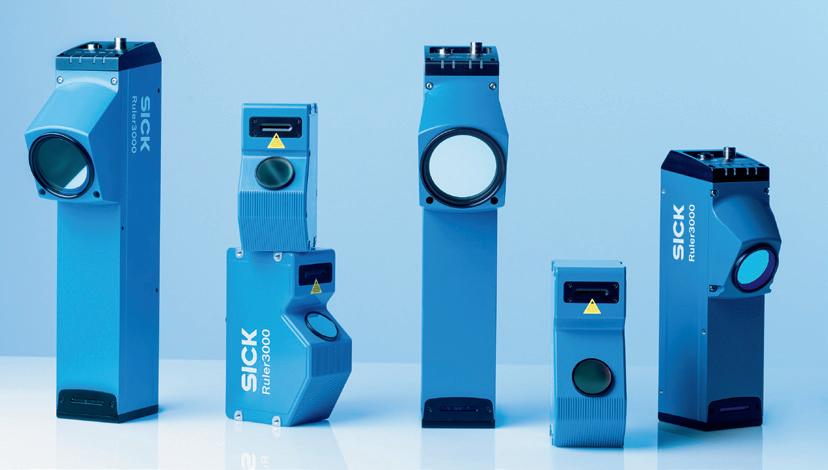
SICK Pty Ltd
https://bit.ly/47uigsa
SAFETY CONTROLLER
The PNOZ m C0 standalone base unit from the PNOZmulti 2 small controller range is now available in Australia.

Pilz Australia Industrial Automation LP
https://bit.ly/3KGjeI5
ETHERCAT SERVO DRIVES

Fatek Automation has released its EtherCAT SC3 Servo Drives, targeted at industries reliant on highspeed and high-precision control.
Global Automation Asia-Pacific Pty Ltd
https://bit.ly/3s9Haxg
8 PROCESS TECHNOLOGY - AUGUST/SEPTEMBER 2023 www.ProcessOnline.com.au
ON WWW.PROCESSONLINE.COM.AU THIS MONTH > > >
>



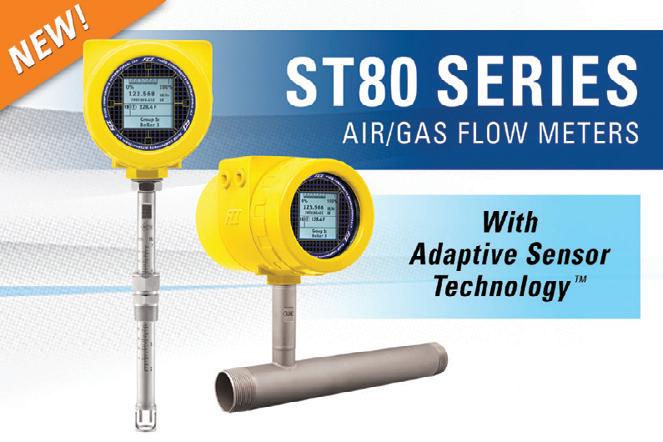
Scalable automation solution optimises process at kaolin processing plant
A new kaolin mining operation in Wickepin, Western Australia, is utilising an integrated automation solution to reduce overall costs, improve scheduling and deliver ongoing benefits to operations.
Kaolin, which is becoming increasingly valuable, is a soft white clay that has been surging in demand, with uses in applications including paper and plasterboard, ceramics, fibreglass, paints and coatings, plastics, rubber, pharmaceuticals and medicine, cosmetics, concrete construction materials and agriculture.
WA Kaolin an ASX-listed mineral exploration, extraction and processing company has developed a proprietary dry processing method known as K99, which turns raw material into market-suitable feedstock for global customers.
Combined with the high quality of the ore reserve, the K99 process delivers highquality, ultra-bright kaolin at a lower cost than conventional chemical bleaching and magnetic separation processing.

WA Kaolin has constructed a Stage 1 commercial processing plant on a three-hectare site in Wickepin, about 200 km southeast of Perth, Western Australia. The site has been identified as having a mineral resource estimate of more than 600 million tonnes of extremely high-grade, easy-access kaolin across its mining and retention tenements, one of the largest known remaining premium primary resources of kaolin in the world.
“In late 2022, WA Kaolin successfully commenced production at the Wickepin Kaolin Project following a challenging development timeline,” said WA Kaolin Chief Executive Officer Andrew Sorensen. “Since then, we have continued to ramp up production to our Stage 1 capacity of 200,000 tonnes of kaolin per annum and commenced planning to increase output at Wickepin towards our Stage 2, 400,000 tonnes per annum target.”
WA Kaolin selected engineering and planning consultancy Willyung Electrical & Controls Engineering (WECE) to manage the process of steadily scaling up. WECE is a WA-based specialist supplier of electrical engineering and control systems integration services for industries including agriculture, forestry, food and beverage, materials handling, mining, water and wastewater.
“After analysing WA Kaolin’s robust and ambitious scale-up plans, we determined that Rockwell Automation had the best automation solution for the project and for the future,” said Chris Bock, Managing Director and Principal Electrical Engineer, WECE.
WECE selected Rockwell Automation’s PlantPAx DCS to provide a single, plant-wide control system, with the flexibility to make better and faster business decisions and a scalable solution for future expansion. The PlantPAx DCS will monitor and run the facility from a single point of control, providing seamless integration into control and power systems, and outputting data that is easy to analyse.
The latest version of PlantPAx DCS has been designed to be an integral part of a digital transformation strategy that boosts productivity and profitability, while reducing operational risk.
“Large projects like the WA Kaolin Wickepin processing plant are complex, and it’s easy to come in over budget or off schedule if the right automation technology isn’t implemented upfront,” said Raj Singh, Channel Manager, Rockwell Automation. “WA Kaolin has taken an intelligent approach by seeking to optimise scheduling and reduce overall costs from the beginning. The cost of a poorly designed control system typically only shows up later in the project, when it’s at its most expensive to address.”
By integrating process, power and information across the plant right from the outset, WA Kaolin was able to achieve a faster time to market, and the system can readily be scaled up as production increases. The plant is currently in production with expansion processes in progress, and with the new DCS in place, WA Kaolin and WECE estimate it will save 20% on costs and achieve a 15% schedule reduction.
The solution also included zero touch computing technologies from Stratus Technologies.
“Working alongside Rockwell Automation and Stratus, Willyung Electrical & Controls Engineering has delivered this solution at the Wickepin Kaolin Project with positive results,” Sorensen said. “Importantly, the control system is a scalable solution and supports WA Kaolin’s strategy to rapidly increase capacity from the processing plant without downtime over the coming years.”
10 PROCESS TECHNOLOGY - AUGUST/SEPTEMBER 2023 www.ProcessOnline.com.au
Automation Australia www.rockwellautomation.com/en-au.html case study
Rockwell













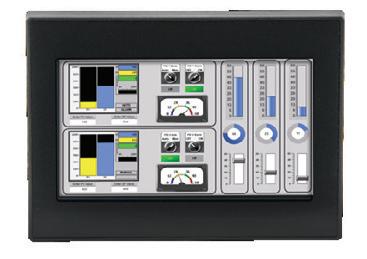



NEW PRODUCTS
DIAPHRAGM SEALS
Noshok provides a wide range of standard, elevated pressure and reduced pressure replaceable and non-replaceable diaphragm seals.
Noshok diaphragm seals are designed to ensure process safety and integrity by isolating and protecting pressure measurement devices from corrosive, erosive, viscous or high temperature process media.

The seals are available with a variety of connection sizes, as well as O-rings and housing materials for a wide range of applications. A wide range of seal types (in-line, flow-through, front flush) and extensive process connections (male and female NPT, flanged and sanitary) are available.
The diaphragm seals are available in a variety of materials, both metallic and non-metallic, with special coatings to meet the requirements of many applications. A wide range of system filling fluids are also available to meet process requirements.
The Noshok-designed diaphragm seals added to pressure measurement devices, filled and calibrated, provide a complete process solution. Certified calibrations traceable to NIST are also available.

To complement the Noshok diaphragm seal range, the company offers a range of accessories including capillaries, cooling elements and sanitary clamps and gaskets.

AMS Instrumentation & Calibration Pty Ltd
www.ams-ic.com.au
RUGGED LAPTOPS
Getac has announced the launch of its next-generation B360 and B360 Pro rugged laptops featuring a wide range of upgrades and refinements.

Key features include an upgraded Intel Core 12th generation i5/ i7 processor with integrated Intel Iris Xe graphics, a 256 GB PCIe NVMe SSD as standard (with option of up to 4 TB) and the 13.3 ″ FHD LumiBond display with Getac Sunlight Readable Technology (1400 nits) and capacitive touchscreen.
The B360 Pro offers an optional NVIDIA GeForce GTX1650 4 GB discrete graphics controller, plus an optional media bay that can accommodate a third SATA SSD (for up to 6 TB storage capacity), a third battery or a DVD drive as required.
Both the B360 and B360 Pro also offer extensive connectivity options, keeping users connected in even remote or isolated environments. These include Wi-Fi 6E AX211, 802.11ax and Bluetooth 5.3 as standard, as well as optional 4G LTE or 5G Sub-6 with integrated GPS.
The updated B360 and B360 Pro are said to increase versatility in the field compared to previous models. Features include an upgraded USB 3.2 port, a Thunderbolt 4 Type-C port, an upgraded HDMI 2.0 port, as well as the addition of a mini-SIM card slot. Both devices also feature dual hot-swappable batteries, while the B360 Pro has the option of a third battery if required.
The B360 and B360 Pro are built rugged for high reliability in the field. Both devices include MIL-STD-810H, MIL-STD-461G and IP66 certification, as well as drop resistance up to 1.8 m.
Getac Technology Corp
www.getac.com
12 PROCESS TECHNOLOGY - AUGUST/SEPTEMBER 2023 www.ProcessOnline.com.au IP68 sealed polycarbonate 1557 Learn more: hammfg.com/1557 ausales@hammfg.com • 08 8240 2244
VALVE-INTEGRATED FLUSHING RINGS
Emerson has introduced the Rosemount 319 Flushing Ring with valve-integrated design, to help achieve accurate differential pressure measurement and lower maintenance in a wide range of differential pressure applications.

Available in Traditional and Compact options, the Rosemount 319 flushing rings provide a process-to-seal connection and allow for faster diaphragm seal maintenance without disconnecting them from process flanges.
Both versions of the Rosemount 319 flushing rings come pre-assembled including the flushing ring, matching valves, and connections, allowing technicians to commission devices faster by eliminating the need to procure and assemble components onsite. Rosemount 319 flushing rings are factory leak-tested so users can mount products to vessels right out of the box. When installed, diaphragm seal maintenance is significantly faster without compromising safety while reducing stocked inventory and management of multiple vendor piece-parts.
The Rosemount 319 Traditional flushing ring design utilises a flow-through cleaning action and can be sized to fit most applications. Configurations are offered with a choice of ball valves, needle valves or gate valves, and in multiple materials, flange types, sizes and ratings.
According to Emerson, the Rosemount 319 Compact flushing ring is designed to remove residual build-up quickly, cleaning five times faster over 30% more surface area and 50% fewer leak points. Assemblies accommodate a wider range of applications due to their smaller footprint, in applications that have limited space for flushing ring installation. Configurations are offered with needle valves and in multiple materials, flange types, sizes and ratings.
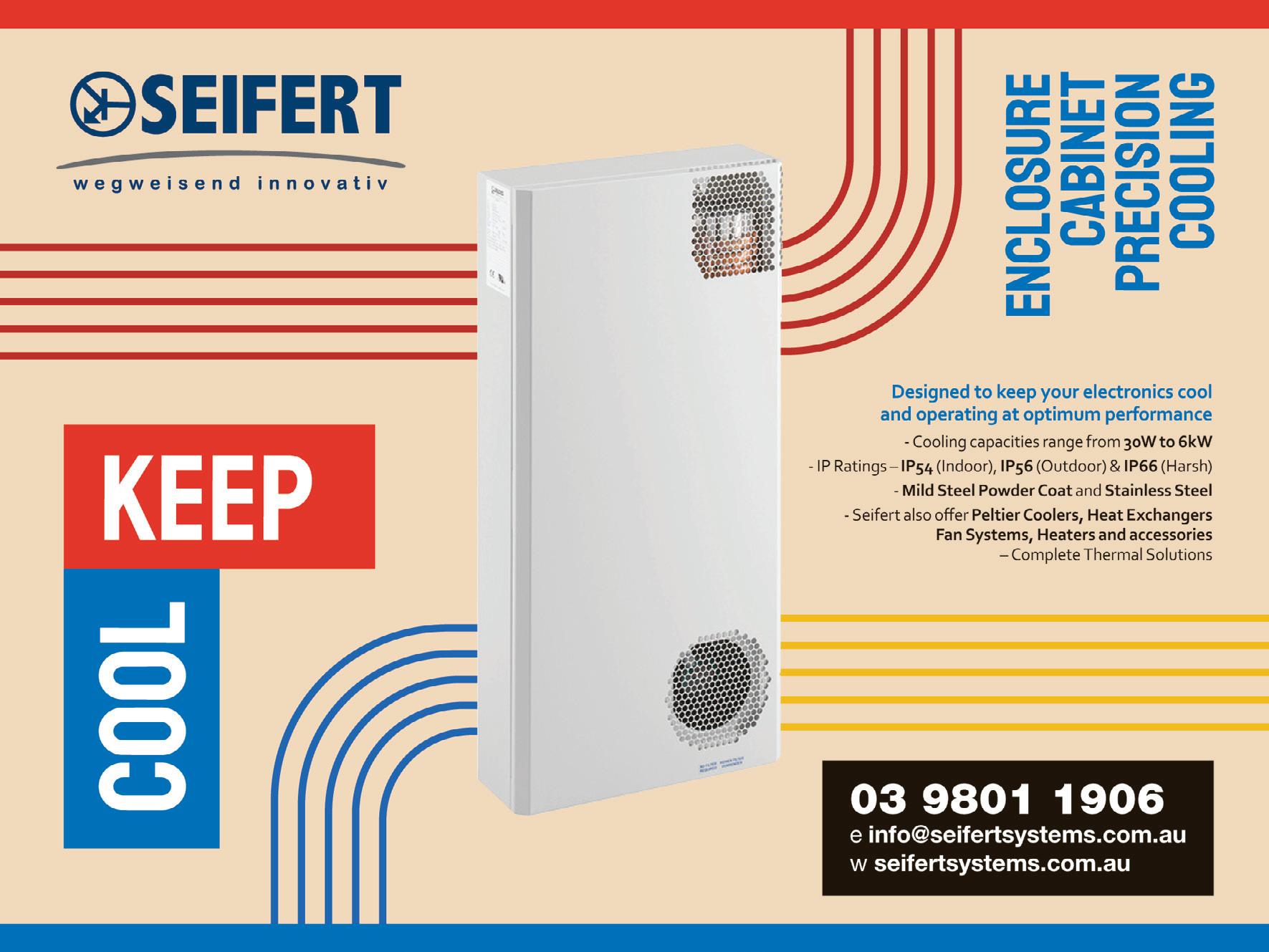 Emerson Automation Solutions
Emerson Automation Solutions
www.emerson.com/au/automation
AUGUST/SEPTEMBER 2023 - PROCESS TECHNOLOGY 13 www.ProcessOnline.com.au NEW PRODUCTS
IN THE DRIVING SEAT
HOW USERS ARE SHAPING THE FUTURE OF THE DCS

14 PROCESS TECHNOLOGY - AUGUST/SEPTEMBER 2023 www.ProcessOnline.com.au
Luis Duran, Global Product Line Manager Safety Systems, Industrial Automation Process Control Platform, ABB
Control systems
Originally built upon purpose-built operational technology (OT), the distributed control system (DCS) has undergone a significant evolution, embracing commercial off-the-shelf technology (COTS). This transformation has unlocked enhanced flexibility and a broader range of options for users, while also enabling information technology (IT) to bridge previously isolated control domains. The shift to COTS has propelled the DCS into a realm of greater adaptability and connectivity, offering users an array of possibilities for optimising their control processes.
Over the past four decades, distributed control systems have undergone a profound evolution, witnessing the addition of numerous functions and an array of benefits. However, in the present day, users are demanding even further advancements. They want the DCS to be increasingly open, expandable and flexible, aiming to leverage the full potential of these systems in addressing their evolving industrial needs. The pursuit of greater openness and adaptability is driven by the desire to stay at the forefront of technological innovation and meet the demands of an ever-changing industrial landscape.
In the past, the traditional DCS market heavily relied on hardware with fixed functionalities embedded in its design. However, the contemporary DCS has undergone a paradigm shift, leaning heavily towards all-software solutions. This transition from hardware to software-driven systems enhances the agility of the DCS, enabling greater adaptability and responsiveness to changing demands.
By leveraging software-centric architectures, the DCS can now embrace plug-and-play components, allowing for the seamless integration of new functionalities and technologies. Furthermore, this shift towards software-based systems liberates users from being tied to a single manufacturer’s proprietary solutions, fostering a more diverse and competitive landscape. As a result, the industry is now empowered to explore a myriad of possibilities and adopt cutting-edge innovations without being limited by hardware constraints. The newfound flexibility and openness in DCS design herald a future of increased collaboration and technological advancement in process automation.
Developments in the services available via the internet and improved connectivity have exposed vulnerabilities in distributed control systems, however, with cybersecurity concerns being one of the most prominent issues. Over the past decade, various industries have recognised the gravity of this challenge, leading to a growing awareness of the need for robust cybersecurity measures. Consequently, there has been a shift in how a DCS should manage and process information, as well as an increased focus on enhancing overall security protocols. The drive to fortify distributed control systems against cyber threats has become a pivotal force, propelling the industry towards more secure and resilient systems that can withstand the complexities of the digital age.
Another factor is the way that some major industries use distributed control systems, which can differ greatly. An example could be a pharmaceutical company experimenting with ways of producing a new drug: it knows it will need to scale up to mass produce the new product and will need different ways to reconfigure equipment to achieve this scale-up. For maximum flexibility,

AUGUST/SEPTEMBER 2023 - PROCESS TECHNOLOGY 15
www.ProcessOnline.com.au
iStock.com/DenGuy
Amid the pursuit of digital transformation, the spotlight is firmly fixed on the transformation of the DCS into the automation system of the future.
Control systems
elements will require a high degree of modularity. This modular approach to production, which allows reconfiguration at will, requires a DCS that can control changing processes without affecting core functions such as control, safety, history logs and alarms.
Modularity also offers the chance to achieve a more cost-effective deployment. Although a company may have planned a DCS as a large capital investment project, it may nevertheless want to begin with a lower level of production to keep initial costs to a minimum. Copying infrastructure and using it for other applications would allow a more cost-effective scale-up of production. It also allows the user to manage capital costs and optimise investment strategies.
Unlocking the potential of data
As the Industrial Internet of Things (IIoT) has advanced, companies recognise the imperative of extracting more value from their data. To harness this valuable information effectively, it needs to be processed and made accessible to specific users, including the latest generation of engineers familiar with immersive digital technologies. These engineers expect to interact with professional tools, such as a DCS, in ways similar to their interactions with tablets and smartphones in their daily lives.
In response to this growing demand, industries are exploring innovative solutions to liberate and leverage the wealth of data captured by distributed control systems. By facilitating seamless integration with modern digital tools, businesses can unlock valuable insights, optimise processes and drive unprecedented levels of efficiency and productivity. Embracing the potential of data holds the key to maximising the benefits offered by the IIoT and drives industries towards a more data-driven and technologically empowered future.
Likewise, certain information may not need to reside within the DCS and can be made accessible through alternative means. The changing demands on the DCS necessitate a different approach, with a more digitalised and open infrastructure, driven by cuttingedge technologies like wireless, 5G and smart digital devices such as sensors and instrumentation in the field. This transformation involves restructuring the DCS, empowering users to seamlessly incorporate new technologies into their existing systems without disrupting the current set-up.
Central to this evolution is the establishment of standardised communication protocols across various devices within a production plant. By adopting open communications, industries can achieve greater interoperability, resulting in more cost-effective integration of system components. Moreover, this open approach enables the decoupling of software from hardware, enabling users to adopt hardware solutions from multiple vendors, fostering a more diverse and dynamic ecosystem of technological offerings.
Embracing these open and digitalised principles revolutionises the way industries interact with distributed control systems, paving the way for enhanced efficiency, agility and adaptability in the face of technological advancements.
Driving change
Historically, DCS providers faced the challenge of striking a balance between adopting cutting-edge IT and communication technology while ensuring a stable and reliable DCS solution for users. However, the paradigm has shifted, with the user community acting as the driving force for fundamental changes in DCS.
One of the prominent user groups is the Open Process Automation Forum (OPAF). Comprising oil and gas and chemical companies, as well as automation providers like ABB, Schneider
BY LEVERAGING SOFTWARE-CENTRIC ARCHITECTURES, THE DCS CAN NOW EMBRACE PLUG-AND-PLAY COMPONENTS, ALLOWING FOR THE SEAMLESS INTEGRATION OF NEW FUNCTIONALITIES AND TECHNOLOGIES.
Electric, Honeywell Rockwell Automation, OPAF aims to establish a new standards-based, interoperable architecture that fosters openness and security. With this architecture, DCS users will gain easy access to leading-edge capabilities, enabling seamless integration of best-in-class components without the need for costly replacements. The standard promotes innovation and value creation, and caters to the diverse needs of multiple industries. Furthermore, it encourages commercial viability and fosters collaboration among DCS users and suppliers.
Another influential user group is NAMUR, a global consortium of process industry organisations. NAMUR has introduced the NAMUR Open Architecture (NOA), an open architecture model that segregates core control and automation functions from nontime-critical monitoring and optimisation. This approach empowers companies to optimise their facilities by accessing critical information currently trapped within the DCS, creating a new layer for maintenance and optimisation.
Although OPAF and NAMUR pursue their objectives through different strategies, both share the goal of defining a common communications interface and information model. While OPAF aims to enhance interoperability and simplify DCS upgrades, NAMUR seeks to complement the DCS with a structure that efficiently accesses necessary information without fundamentally altering its core operations.
Addressing modularity, the modular automation initiative aims to move away from monolithic automation systems and embrace more flexible modules. By enabling the seamless combination of modules, this approach allows for rapid process implementation, easier capacity scaling and swift changeovers of products, ultimately promoting efficiency and adaptability in diverse industries.
Embracing open standards
The demand for open standards is gaining momentum across major industries, encompassing not only traditional sectors like chemicals, pharmaceuticals, oil, and gas refining but also extending to data centres. This trend reflects a growing inclination towards advanced technologies that enable industries to optimise their capital investments and achieve rapid production capabilities. Moreover, industries seek long-term stability and reduced total expenditure (TOTEX) through the adoption of open standards.
As the momentum towards open standards continues to build, industries stand to gain enhanced connectivity, greater interoperability and improved data accessibility. By enabling greater collaboration and innovation, the adoption of open standards enables industries to fully harness the potential of their automation systems and unlock new opportunities for growth and success.
ABB Australia Pty Ltd
www.abbaustralia.com.au
16 PROCESS TECHNOLOGY - AUGUST/SEPTEMBER 2023 www.ProcessOnline.com.au
ELECTRO-HYDRAULIC VALVE ACTUATORS
Rotork has introduced a compact quarter-turn design to its Skilmatic SI range of self-contained electro-hydraulic actuators. The latest actuator uses a rack-and-pinion drive for a torque output of up to 1000 Nm.
The SI range of actuators are said to combine the simplicity of electrical operation with the precision of hydraulic control and the reliability of mechanical spring-return fail-safe action. Typical applications for Skilmatic SI actuators include functional safety-related emergency shutdown (ESD) and remotely operated shutoff valve (ROSoV) duties.

With a wide choice of operating speeds, ESD options include single or dual inputs and partial stroke testing (PST) to meet a wide range of applications. All actuators are available with hazardous area certification and are suitable for use in SIL 2/3 systems.
The actuator data logger is capable of storing up to 3000 events. Users can export data logs to Insight 2 or Rotork’s cloud-based Intelligent Asset Management (iAM) system.
Offering the flexibility of customisation to suit the application, SI range actuators can be integrated into the majority of digital bus control systems, including Rotork’s Pakscan network, Foundation Fieldbus, DeviceNet, Profibus, Modbus and HART.
The SI range delivers quarter-turn torque output up to 200,000 Nm and linear thrust output up to 400 kN that are suitable for valves of virtually any size and design.
Rotork Australia
www.rotork.com
ULTRASONIC FLARE GAS FLOW METER
The Lauris Technologies FF1225 Series ultrasonic flare gas flow meter is designed to deliver accurate flare gas measurement over a wide range with minimal maintenance intervention.
The flow meter is offered with several options, including local or remote mount transmitter, temperature and pressure transducers, and a multipath version that provides flow uncertainty of better than 1%.
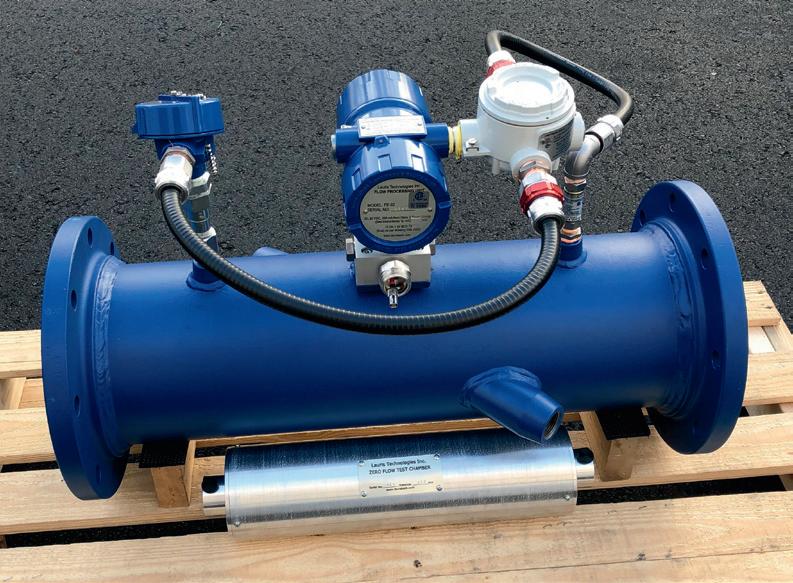
Both the local and remote LCD displays show velocity, flow rate, total flow, temperature and pressure. The onboard memory of the transmitter display allows for storage of up to 250,000 data points. Total data stored is defined by the sample rate programmed by the user.
The product is based on proprietary ultrasonic transit-time measurement with minimum detectable gas velocity of lower than 0.01 m/s. The maximum velocity measurement capability of 100 m/s standard and 150 ms (optional) provides turndowns of 10,000:1 through to 15,000:1.
AMS Instrumentation & Calibration Pty Ltd
www.ams-ic.com.au
SILICONE KEYBOARD
Gett Asia’s KSI-U10200 Cleantype Prime Series PRO and PRO+ silicone keyboard is designed for desktop use in sterile environments. With an IP68 protection rating, the KSI-U10200 is washable and fully submersible, making thorough sanitation possible without damage. Its 100% silicone-sealed surface ensures that it is dustproof, safeguarding against contaminants. It is therefore suitable for laboratory and food production areas where cleanliness is paramount.
The KSI-U10200 offers full functionality, with alternative key layouts available on request, and the PRO+ version offers adjustable backlight brightness for optimal visibility in various lighting conditions. The keyboard also features magnetic mounting for easy attachment and a keylock button that temporarily disables the keys for cleaning.

Backplane Systems Technology Pty Ltd
www.backplane.com.au
AUGUST/SEPTEMBER 2023 - PROCESS TECHNOLOGY 17 www.ProcessOnline.com.au NEW PRODUCTS
MODULAR EDGE SOLUTION
Advantech has introduced the MIC-770 V3 Modular IPC, a GPU edge computing solution validated with NVIDIA L4 GPU NVQual. With compatibility for the NVIDIA L4 Tensor Core GPU, it offers 7424 CUDA cores, 24 GB GDDR6 GPU memory and a low 72 W power consumption. The high-performance, compact design is suitable for AIoT applications in factory automation.
Powered by a 12th Gen Intel Core-i processor, the MIC-770 V3 is designed to enable quick development of GPU-accelerated solutions. Its small form factor, coupled with the MIC-75M20 expansion i-Module, makes it energy-efficient and suitable for AI-based edge computing and inference. It provides energy-efficient universal acceleration for AI inference, video and graphics applications.
The modular design of the MIC-770 V3 allows for PCIe expansion using Advantech i-Modules and Flex I/O. Adding a PCIE-1674 vision frame grabber card enables camera connectivity, while four GbE Flex I/O enables LiDAR system integration for shape and distance detection, facilitating the rendering of 3D models by the NVIDIA L4 GPU.

For remote management, the MIC-770 V3 supports the iBMC 1.2 Edge Intelligent Solution. Leveraging hardware-based out-of-band (OOB) management technology, the Advantech WISE-DeviceOn solution provides access, configuration, monitoring and analysis of IoT network assets.
The MIC-770 V3 also incorporates an advanced thermal design with support for a wide operating temperature range and a dedicated server-grade air duct to effectively manage GPU temperature, delivering high performance and clock frequency residency. The design allows the MIC-770 V3 to achieve 30.3 TFLOPs computing power while consuming only 72 W of power.
Advantech Australia Pty Ltd

www.advantech.net.au
TORQUE SENSOR
The NCTE Series 2300 torque sensor is mainly used in automotive test facilities, professional testing construction, climatic exposure test cabinets (exceeding dewpoint), process monitoring and medical engineering. Transmitted torque can be measured statically and dynamically in real time. Each sensor can be configured individually with a range of extras, such as an angle sensor.
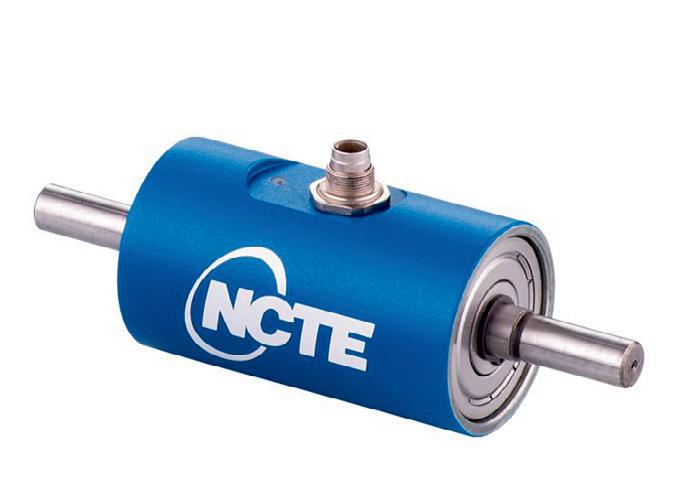
The Series 2300 offers a wide range of output signals such as 0–10 V, 4–20 mA, CANbus or USB. When using USB, special NCTE software enables the viewing of data in real time. The sensor is provided as a complete unit with integrated evaluation electronics, a 5 m cable, keystones and factory calibration certificate, and in case of the digital output, a 2.8 m USB cable.
This sensor has a mechanical interface (for power transmission, adapter connections are provided at both ends of the keystone round shafts) and an electrical interface (a socket for power supply and signal output is attached to the upper side of the housing).
The NCTE Series 2300 torque sensor can measure nominal torque up to 100 Nm with an accuracy of ±0.5%, bidirectional, at a speed of up to 10,000 rpm. Available torque ranges are 0.5, 1, 2.5, 5, 10, 20, 50 and 100 Nm. The protection class is IP50 and the operating temperature range is -30 to +85°C.
Slentech Pty Ltd
www.slentech.com.au
18 PROCESS TECHNOLOGY - AUGUST/SEPTEMBER 2023 www.ProcessOnline.com.au NEW PRODUCTS
THE INS AND OUTS OF I/O LOCAL, REMOTE AND DISTRIBUTED
Process and factory automation controllers connect to a wide variety of sensors, instruments, valves and other equipment through I/O cards or racks that are either co-located within the same cabinet (local) as the controller or CPU or installed remotely.

Defining the difference between local and remote I/O is straightforward. Still, the defining differences between remote I/O and distributed I/O can be more nuanced. They can be further confounded by vendors’ definitions or marketing collateral, just as many automation vendors prefer to use a name such as process automation controller (PAC) over programmable logic controller (PLC).
The most used I/O type is local I/O, usually from the same vendor as the controller or CPU, directly connected via integrated racks or cages holding 4-, 8-, 16- or 32-point I/O cards. Some local I/O expansion racks are separate but connected to the CPU through digital buses or highways via twisted pair wires or Ethernet cables, within the same cabinet.
Since local I/O is typically intended to be installed within the same enclosure as the controller or CPU, environmental operational characteristics and hazardous area approvals tend not to be as robust as for remotely installed I/O. Next comes the challenge of outlining the differing characteristics between remote I/O and distributed I/O, especially since many vendors refer to them interchangeably. Remote I/O came first and thus tends to be less flexible, capable
and smart when compared to later-released distributed I/O.
Remote I/O was originally local I/O reconfigured and housed to be remotely installed from its corresponding controller. Communication was no longer along a backplane but now designed to convert its connected analog I/O signals to a digital format that was transmitted back to the host controller over proprietary buses or highways.
Remote I/O lacks complex or advanced CPUs or processors to handle maths, complex control or peer-to-peer communication with other remote I/O modules, nor does it allow the connection of additional I/O modules. Though surpassing local I/O in operational characteristics and hazardous approvals, remote I/O is still more limited than local I/O.
The advanced capabilities of distributed I/O generally exceed remote I/O capabilities, as it is a more complex technology that can be distributed throughout a process plant or automation facility, and does not need constant communication with the host controller. This is because most distributed I/O devices contain advanced CPUs and real-time operation systems that allow localised control and monitoring, and other capabilities.
Distributed I/O can stand alone and can be a preferred choice over remote I/O due to its redundancy should it lose its connection with the controller.
Designed for remote installations, distributed I/O suits installation in harsher
operating environments. They often have a minimum of Class I, Div 2/Zone 2 approvals, and occasionally Zone 0/1 approvals. Distributed I/O can be well suited to serve as a local controller and I/O device but may have additional built-in capabilities to support peer-to-peer communications and gateway functions such as HART to Modbus RTU or Modbus/TCP conversion. They usually also contain embedded webservers for real-time data viewing, data logging and even IIoT or Industry 4.0 capabilities employing the MQTT protocol for seamless connections to cloud services like AWS or Microsoft Azure.
Recent advances in secure spread spectrum, long-range and mesh wireless telemetry have further enabled I/O devices to provide solutions once thought impossible. Wireless HART, ISA 100 and many proprietary short- and long-range unlicensed solutions are now optionally embedded directly within the I/O device itself, spawning an entirely new category of remote or distributed types of I/O solutions.
I/O devices, regardless of type, have advanced incredibly fast during the last decade. So much so that several of the abovementioned differentiators have blurred the once-defined lines that separated them. For the user, it is imperative that each vendor’s solution and technology offering be thoroughly examined to ensure functional, operational and design compliance.
AUGUST/SEPTEMBER 2023 - PROCESS TECHNOLOGY 19 www.ProcessOnline.com.au
Control systems
Moore Industries www.miinet.com
iStock.com/Otakeja
INTENSIFIED CAMERA

The iNocturn from Photonis is an intensified camera combining an image intensifier tube with a sensitive, low-light camera. It features a combination of high sensitivity, low SWaP, high frame rate, high-QE photodetectors and nanosecond gating. The intensified camera can detect different wavelength ranges from deep UV to NIR and is suitable for applications in fluorescence imaging, electrical discharge detection, microscopy and spectroscopy. The camera’s high-resolution sensor is also equipped with a high frame rate for high-speed moving objects in applications such as industrial monitoring.

Small, compact and lightweight, the iNocturn intensified camera offers 1280 x 1024 pixel resolution, frame rates up to 100 fps at full resolution, spectral range from 200–1100 nm, depending on choice of photocathode. With either gated or non-gated options the minimum detection capability is up to a single photon. Connection is via PAL/NTSC, CameraLink, HD-SDI, USB 3.0, LVCMOS, C-mount. The operating temperature range is -10 to +55°C.
Due to Smart Tube Management, the iNocturn range of cameras produces high-quality images and videos supporting the ability to perform single photon detection, with a low read noise reached without the need for any additional cooling.

With different ranges of wavelength spanning from deep UV to near infrared, the user can focus on a specific wavelength range for a particular application. For example, spark and electrical discharge detection application is very suitable with the iNocturn SUV, while the iNocturn Blue or Green can be used for other applications that include wafer inspection, spectroscopy and microscopy.
SciTech Pty Ltd www.scitech.com.au
TOWER LIGHTS
The TL 305 series tower lights from Leuze offer bright and homogeneous illumination as well as an optional IO-Link interface.
Tower lights are needed in machine and system construction as well as in intralogistics: they make states, faults and ongoing processes clearly visible from a distance. They light up brightly, enabling optimum signalling — whether at the machine, on the conveyor belt or for access control. The compact towers are available preconfigured with three, four or five segments. The range includes the TL 305 models with predefined colour assignment as well as the TL 305-IOL models with IO-Link interface. The IO-Link variants allow different operating modes and provide a wide selection of colours, which are also available with additional acoustic signaller on request.
The M30 thread and M12 connector make them easy to install, and matching accessories are available to simplify installation. The aluminium housing allows the tower lights to be used even in demanding industrial environments.
The IO-Link version TL 305-IOL with its different operating modes offers maximum flexibility. Segment mode enables the segments to be actuated individually via IO-Link. This allows colour, intensity and lighting sequences to be configured individually. Level mode is used to visualise fill levels. If fast commissioning is required, users can actuate eight predetermined or user-defined configurations via the three external trigger inputs even without an IO-Link connection.
Leuze electronic Pty Ltd www.leuze.com.au

20 PROCESS TECHNOLOGY - AUGUST/SEPTEMBER 2023 www.ProcessOnline.com.au NEW PRODUCTS
WirelessHART GATEWAY


Endress+Hauser has launched its FieldGate SWG50, a WirelessHART gateway designed for secure communication from field devices. FieldGate SWG50 is compact and ready for Netilion integration while providing an easy-to-use solution for multiple standard monitoring applications across various industries. Netilion is a cloud-based IIoT ecosystem designed for industrial processes, connecting the physical and digital worlds to send information from the field straight to a phone, tablet or another device.

The FieldGate SWG50 WirelessHART gateway enables users to monitor measurements and health status using WirelessHART connectivity. It is designed to be an economical alternative to complex cable installations, reducing expenditure for process automation by up to 30%, adapting a process plant, both in greenfield and brownfield applications, with simple access to digital communication.
Routinely used in monitoring applications, the WirelessHART network is a solution for standard level measurement, energy management or machinery performance monitoring. As a gateway ready for digitalisation, the integration of FieldGate SWG50 into Netilion is simple and transparent using EdgeDevice SGC500.
FieldGate SWG50 can be paired with Endress+Hauser’s FieldPort SWA70 and SWA50 adapters. It also integrates with any WirelessHART device.
The FieldGate SWG50 allows for network migration, allowing users to change the network ID and join keys for the complete network after the network is running and offers a colour-coded device list for a simple understanding of the device status.
Four RJ-45 connectors provide connection of plant and cloud networks as well as its web interface for configuration, providing both Modbus TCP and HART-IP protocols.
Endress+Hauser Australia Pty Ltd

www.au.endress.com
INDUSTRIAL COMPUTERS
Adlink Technology has announced the MVP-5200 series compact modular industrial computers powered by 12/13th Gen Intel Core i9/i7/i5/i3 and Celeron processors. Featuring the Intel R680E chipset and supporting up to 65 W, the computers can also incorporate GPU cards in a rugged package suitable for AI inferencing at the edge, and can be used for but not limited to smart manufacturing, semiconductor equipment and warehouse applications.

Other I/O options include two DisplayPort, two HDMI, four COM ports, six USB ports, 8-channel digital I/O, three 2.5 Gb LAN interfaces and six SMA antenna connectors (four for 5G and two for Wi-Fi). For additional extension, there is one M.2 2230 A+E-key for Wi-Fi and 5G modules, one 3042/3052 B-key slot and one M.2 2280 M-key for additional storage.
The MVP-5200 series are scalable with an ADLINK AFM (Adaptive Function Module) slot. ADLINK offers a Function Modules Design Service that allows users to customise their functional expansion options according to their specific requirements. This includes but is not limited to four main categories: application-specific connectors, integrated circuits, add-on expansion slots and standard industrial I/O ports. By choosing different function expansion modules, users can enhance the system’s capabilities and allowing seamless connectivity to external devices as required.
ADLINK Technology Inc
www.adlinktech.com


AUGUST/SEPTEMBER 2023 - PROCESS TECHNOLOGY 21 www.ProcessOnline.com.au NEW PRODUCTS
PoE ETHERNET SWITCH
The ICP DAS iNS-308 is an IoT switch with eight PoE/PoE+ ports, compliant with IEEE 802.3af/at and offering up to 30 W per port, with a wide range power supply input of 24–57 VDC.
An Ethernet bypass for Ports 7 and 8 is designed to provide uninterrupted data transmission even during power failures.
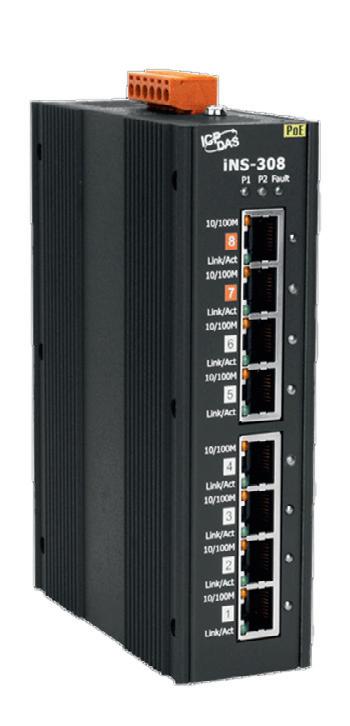
A simple Web UI lets users remotely monitor and manage the power supply status of the PoE devices. The switch supports power scheduling, which automatically turns off power to devices when not in use, achieving energy conservation.
The device also supports SNMP v2c, Modbus and MQTT functions. Additional features include redundant and boost power design, making the iNS-308 a suitable choice for PoE applications without a 48 V power supply.
ICP Electronics Australia Pty Ltd www.icp-australia.com.au
POWER SUPPLY MODULES
Beckhoff Automation has announced 48 V, 40 A power supply modules for its cabinetfree MX–System range.
The 48 VDC power supplies are plugged onto a baseplate and supplied with the primary voltage via the standardised system interface without manual wiring. The power supplies become participants in the EtherCAT network via the second MX-System interface. This data interface also offers the possibility of feeding the 48 V supply into the baseplate. In this case, both 48 VDC and 24 VDC can be used by the corresponding function modules.
The MX-System range offers function modules that provide 48 V as power voltage for servo drives and stepper motors. Existing 10 and 20 A power supply modules feed exclusively into the backplane, while the 40 A variants are designed so that 48 VDC devices can also be directly attached via connectors on the front of the function module. Four versions are available: a module variant with M12 connectors for attaching AMI8100 distributed servo drives; a version with two B23 connectors for attaching feed segments of the Beckhoff XTS transport system; a module for connecting a base module of the ATRO modular industrial robot; and a variant without connectors for direct line connection that feeds exclusively into the backplane.

Several power supplies can be connected to a baseplate and operated in parallel to balance peak loads. The power supplies also have the ability to feed regenerative energy directly back into the machine’s supply network, such as that generated while the servomotors are braking.
Beckhoff Automation Pty Ltd www.beckhoff.com

22 PROCESS TECHNOLOGY - AUGUST/SEPTEMBER 2023 www.ProcessOnline.com.au NEW PRODUCTS
LED BEACONS
Turck has expanded its range of LED lights with the addition of the K100 series LED indicators. The 100 mm beacons were developed by Turck’s partner, Banner Engineering. They are available in two configurations.
The Pro Daylight Visible beacon model offers 12 audible options and features extra-bright indication in both indoor and outdoor environments. The model’s clear lens provides distinct indication, even in sunlight, avoiding false indications. It features three colour options (green, yellow and red) with multiple single- and dual-colour animations, and can be used for operator guidance, status indication and other functions.

The K100 Pro Indicator model has a diffused lens that appears white when inactive, thereby preventing false indication. It features 14 colour options that can be used for status and indication applications. Animations include options such as flash, intensity sweep and wave.
Both beacon models can include an optional audible alarm and have an IP66 environmental rating for dust, rain and snow.
The beacons are operated by discrete inputs. They are suitable for users who do not have IO-Link but who want the extra control and customisation capabilities to communicate information visually. Using Banner’s Pro Editor software, the user can program device status, audible signals, colours and animations.

The PC-based interface makes it easy to configure a beacon for a wide range of applications, such as displaying machine warm-up time, indicating unique steps in an assembly process and communicating multiple machine states.



Turck Australia Pty Ltd www.turck.com.au


AUGUST/SEPTEMBER 2023 - PROCESS TECHNOLOGY 23 www.ProcessOnline.com.au 9303P&SS-WNIPT5-50GJ AuSTrAlIAN
high performance steam traps CONA
B – Bimetallic M – Thermostatic TD – Thermodynamic
CONA “All-in-One” Multi-valve system
CONALIFt Mechanical condensate pump Tel: (03) 9699 7355 www.pressureandsafetysystems.com.au NEW PRODUCTS
AGeNT & STockIST
SteAm trApS
CONA S Ball float steam trap
CONA p Pump trap
LIGHT CURTAIN OR SAFETY LASER SCANNER?
CHOOSING AN OPTICAL SAFETY DEVICE
From machine building to parts manufacturing to industrial vehicles, safeguarding machinery is a critical step to ensuring the safe and productive operation of any manufacturing facility. Safety light curtains and safety laser scanners are two common safeguarding devices, and both can be used for many safety applications, including point-of-operation guarding, area guarding, perimeter protection and entry/exit safeguarding.

But how do you choose the right technology for your safety application? While it is strongly recommended to consult a safety professional about your specific application requirements, below are some general considerations that can help identify an appropriate safety technology.
Point-of-operation guarding
The point of operation refers to the area of the machine where work is performed. In protecting points of operation, a person’s approach is detected within a very close proximity to the hazardous point. The advantage of using an optical device for point-of-operation protection is that it may allow for a short minimum distance and the operator can work more ergonomically (eg, during loading work on a press).
Using a light curtain for point-of-operation guarding
With a safety light curtain, the sender unit emits pulses of infrared light beams to a receiver unit. The light curtain can then detect interruptions to one or more light beams within the sensing field. Safety light curtains are ideal for point-of-operation protection
24 PROCESS TECHNOLOGY - AUGUST/SEPTEMBER 2023 www.ProcessOnline.com.au
Safety light curtains and safety laser scanners are the two most common machine protection technologies, and both can be used in many safety applications.
Aaron Schulke and Aaron Woytcke, National Product Specialists at SICK
due to their slim profile that can easily be mounted close to the hazard and their small resolution between beams. For example, the resolution can be set small enough to detect a hand or even one finger. This allows the safety system to respond quickly when the sensor is tripped.
Using a safety laser scanner for point-of-operation guarding
A safety laser scanner is less likely to be used for this type of application, since laser scanners generally require a greater minimum distance from the hazard, due to the longer response time of the device. Another possible option for point-of-operation guarding would be a safety-rated vision system.
Important considerations
When choosing a safety technology, you must always consider the minimum safety distance calculation.1 This is especially important for point-of-operation applications because people are working so close to the hazard that you must ensure that the machine can be stopped before injury occurs. It is also important to consider the size and discreteness of the optical safety device. The device should be able to protect a worker from injury while also maintaining an ergonomic workspace.
Area protection and perimeter guarding
Area guarding and perimeter protection are sometimes used in similar applications. There are important differences that can help determine an appropriate optical safety device.
Area protection refers to safeguarding a hazard point by monitoring an area in the zone by which a person would approach a hazardous point. The approach of the person is detected by sensing the person’s presence in an area. Area protection can sometimes be necessary for machines that have a hazardous area that cannot be viewed completely from the position of the reset device. If the hazard area is entered, a stop signal is initiated stopping the machine and preventing restart. Hazard area protection is also important for AGVs (automated guided vehicles), transfer cars and for cranes and stackers, in order to protect people while the vehicles are in motion, or docking to a fixed station.
Perimeter guarding refers to safety measures that guard one or more sides of the machine. If the perimeter is breached, a stop signal is initiated and the machine is stopped. Typically, safety laser scanners are used more in area protection and safety light curtains or multiple beam systems are used more in perimeter guarding applications. You should always discuss your specific application needs with a qualified safety professional.
Using a light curtain for area and perimeter guarding
Since the light curtain uses the sender/receiver concept, it can easily be used in conjunction with mirrors to guard multiple sides of a machine. Depending on the set-up, you could also potentially mount light curtains very close to the machine, saving valuable floor space.
Using a safety laser scanner for area and perimeter guarding
Using time-of-flight technology, a safety laser scanner emits a pulse of light that is then reflected by a target, if present. The time required for the pulse to travel between the scanner and the reflector and back again is proportional to the distance. This allows the scanner to detect objects in the defined safeguarding area.
Because the safety laser scanner is based on software-configured freely defined fields, it may be able to be tucked into the machine for discrete mounting. Additional benefits of a safety laser scanner include the ability to switch between zones and the ability to segment field types for different outputs eg, safety (protective) field or warning field.

AUGUST/SEPTEMBER 2023 - PROCESS TECHNOLOGY 25 www.ProcessOnline.com.au
Machine safety
iStock.com/Traimak_Ivan
Important considerations
As with all safety applications, a minimum safety distance calculation is an essential step. In addition, for both area and perimeter guarding, it is important to consider whether optical guarding or hard-guarding (completely preventing access to the area) is the most appropriate safety measure. You should also weigh the benefits of fenceless safety, while taking into account foot and AGV traffic in the area. For example, in some factory floor configurations with high traffic and narrow separation between guarding areas, hard-guarding may be more suitable to minimise tripping the optical safety devices and causing the machines to come to a stop.
Entry/exit guarding
In many applications (such as palletising) objects must enter the guarded area via conveyors while the machinery remains in motion. It is therefore necessary to allow entry and exit of objects while still protecting personnel from danger.
Using a light curtain for entry/exit applications
Traditionally, if differentiation between goods and a person is required to allow goods to access a hazard zone, muting is used in conjunction with light curtains or multiple beam devices to allow entry/exit of the material or goods, but not a person. Muting is defined as the ‘temporary, automatic suspension of the safety function’. It can be used to temporarily deactivate the protective function of a protective device, allowing material or goods to pass through without initiating a stop of the machine. This can be done using two or four muting sensors, such as inductive sensors or photoelectric sensors, which are logically evaluated to determine the sequence of the object moving through. If the sequence is cor-
rect, and all other parameters within the logic are met, the object will be allowed through the safety light curtain without stopping the work routine.
Another way of moving material into or out of a safeguarded area with a light curtain is active differentiation between person and goods. For this application, horizontally arranged softwareconfigurable safety light curtains are applied. The ability to evaluate each light beam individually allows the light curtain to differentiate the interruption pattern of the material or material carrier (such as a pallet) from a person. This differs from muting on two levels. Muting sensors are not required, so there is less mechanical mounting effort and less wiring needed; and because the light curtain is now continuously active, (ie, there is no suspension of the safety function) the application no longer involves ‘muting’.
By using self-teaching dynamic blanking, as well as other differentiation criteria such as direction of movement, speed, entry and exit in the protective field etc, a safety-relevant distinction can be made. In this way, undetected entry into the hazard zone can be prevented.
Using a safety laser scanner for entry/exit applications
Active switching of protective fields provides another way of moving material into or out of a safeguarded area. For this application, safety laser scanners are normally used with a vertical protective field.
The appropriate protective field, from a series of preconfigured protective fields, is activated by corresponding signals from the machine controller and suitable, appropriately positioned sensors. The contour of the protective field is designed so that passage of

26 PROCESS TECHNOLOGY - AUGUST/SEPTEMBER 2023 www.ProcessOnline.com.au
Machine safety
Figure 1: Safety laser scanners being used for perimeter guarding.
the material does not cause the protective device to activate and any unmonitored areas are small enough to prevent undetected access to the hazard zone.
Important considerations
We most often see safety light curtains in entry/exit applications because it is an effective and economical solution in most cases. However, there are certain instances where you might want to use a laser scanner instead. For example, if you do not have an appropriate space to mount two perpendicular devices, a laser scanner would be the more feasible choice.
Fenceless safety
In fenceless safety set-ups, the laser scanner monitors hazardous areas of machines by scanning its surroundings in two dimensions. As soon as the safety laser scanner detects an object or person in the protective field, safe machine shutdown is initiated. Warning fields can be used to detect an intrusion before impacting the protective field, signalling an audible or visual alert, or machine slowdown.
There are four benefits of fenceless machine safety: increased productivity, customisability, out-of-the-box solutions and affordability.
Increased productivity
Hard guards or mechanical fences limit access to machines and make changeovers more complicated and time-consuming. Safety mats, light curtains and other perimeter guarding also consume extra space for installation and the required safe stopping distances. In contrast, fenceless safety is a non-contact solution, saving floor space and improving access to machines for quicker changeover.
Customisation
With fenceless safety, the laser scanner is used to make the safety solution fit the application, rather than force the application to conform to the safety system. The scanner’s monitoring field conforms to the unique shape of the machinery and hazardous areas, without impeding worker accessibility and process productivity.
Out-of-the-box solutions
Unlike their hard-and-fast counterparts, fenceless safety is an out-of-the-box solution. With safety laser scanners, you simply disconnect power to the scanner, move it to the new location and reconfigure the new safety zones using the built-in software.
More affordable
The cost of technology has decreased over time, and the flexibility, robustness and configurability offered now means that fenceless safety is a viable, cost-effective option.

Conclusion
Machine builders and end users should consult with a qualified safety professional to discuss the most appropriate safety system for their application. It is best to work with a trusted supplier who has demonstrated competency with a variety of safety sensors and protective devices, and who can also provide your staff with certified functional safety training and other safety services such as risk assessment and system validation.
1. SICK USA Blog 2021, How to Calculate Safety Distance for Light Curtains, <<https://sickusablog.com/calculate-safety-distance/>>
SICK Pty Ltd www.sick.com.au
AUGUST/SEPTEMBER 2023 - PROCESS TECHNOLOGY 27 www.ProcessOnline.com.au
Figure 2: Light curtains in an entry/exit guarding application.
Machine safety
ETHERNET I/O MODULE
Turck’s TBEN-S1-4DXP Ethernet I/O module is designed for use in applications with a low I/O requirement, such as in many logistics applications. The compact block module provides four channels that can be used flexibly as inputs or outputs in the same housing as the TBEN-S, which comes as standard with eight channels. With an operating temperature range from -40 to +70°C and protection to IP65/IP67/IP69K, the I/O module has a wide range of applications.

In applications where a small number of I/Os are collected and transferred over long distances, users benefit from the full flexibility of the TBEN-S compact module design, but with additional cost efficiency. The robust IP69K TBEN-S1-4DXP is suitable for decentralised automation, which reduces commissioning and wiring effort. As a multiprotocol device, it can be used automatically in Profinet, EtherNet/IP or Modbus TCP networks without any intervention by the user.

Turck Australia Pty Ltd www.turck.com.au
DATA SERVER FOR AMS DEVICE MANAGER
Emerson has released AMS Device Manager Data Server to securely extend intelligent field device data to outside systems to make it easier for reliability and maintenance teams to further capitalise on modern advanced analytics software.

For decades, process manufacturers have relied on asset management software to carefully deploy and monitor plant production assets — like measurement and analytical instrumentation, digital valve controllers, wireless gateways and others — both within a single plant and across the enterprise. As plants have evolved, they’ve grown their technology stack to adopt a wide range of analytics, historians, machine learning and advanced modelling to exploit and benefit from historically underused or inaccessible datasets from around the plant. AMS Device Manager Data Server is designed to publish intelligent field device data nearly instantaneously to industrial software analytics solutions already in use by the user, eliminating the need for complex custom data integration and manual workarounds that often cause delayed results and siloed data. The data is relayed via secure industry protocols.
Emerson says that AMS Device Manager Data Server makes it easy to import critical instrument and valve data into common dashboarding tools and applications like Microsoft PowerBI; Emerson software tools such as the Plantweb Optics platform, Plantweb Insight, Aspen MTell and AspenTech Inmation; plant historians; and others.
Emerson Automation Solutions
www.emerson.com/au/automation
28 PROCESS TECHNOLOGY - AUGUST/SEPTEMBER 2023 www.ProcessOnline.com.au ROLEC OKW Australia New Zealand Pty Ltd Unit 6/29 Coombes Drive Penrith NSW 2750 Phone: +61 2 4722 3388 E-Mail: sales@rolec-okw.com.au www.rolec-enclosures.com.au A POWERFUL SOLUTION
profiPANEL command enclosures & the profiPLUS suspension system: Made for Industry. Made for your HMI. Made in Germany. NEW PRODUCTS
FOR ALL HMI-PANEL-PC‘S
TILT-DOWN SCREW CONVEYOR
Flexicon has released a mobile tilt-down flexible screw conveyor that fits restrictive processing situations and offers a low centre of gravity with full accessibility from standing height.

Positioning of the support boom against and parallel to the conveyor tube minimises the height needed to manoeuvre the system under doorways and mezzanines, and to fit the conveyor’s discharge between process equipment inlets and overhead obstructions. A low centre of gravity maximises stability during operation and when rolling the unit between multiple processing tasks and washdown stations.
When fully lowered, the tilt-down mechanism positions the clean-out cap of the conveyor tube higher off the plant floor and the conveyor’s discharge closer to the floor, allowing removal and re-insertion of the flexible screw from standing height during cleaning and inspection.


The screw is the only moving part contacting material and is driven beyond the discharge point, preventing material contact with bearings or seals. It self-centres as it rotates, providing clearance between itself and the tube wall to eliminate or minimise grinding, while creating a gentle rolling action that prevents segregation of the most disparate blends.
Constructed of 316 stainless steel finished to sanitary standards, the mobile system is equipped with a low-profile hopper with bag support tray, quick-release clean-out cap, quick-disconnect discharge access cover, and stainless control panel and liquid-tight compression fittings, allowing washdown and conveying of corrosive materials. Flexicon Corporation (Aust) Pty Ltd www.flexicon.com.au
AUGUST/SEPTEMBER 2023 - PROCESS TECHNOLOGY 29 www.ProcessOnline.com.au
NEW PRODUCTS
Harzardous area equipment that is compliant, fit for purpose and delivered on time.
LATERAL CONNECTION TERMINAL BLOCKS
Weidmüller’s latest Klippon Connect terminal blocks with lateral PUSH IN connection are designed to offer a solution for efficient and safe wiring in confined distribution boxes. The terminal blocks combine the advantages of screw connection technology with the simple operation of PUSH IN technology. This allows for tool-free, well-organised wiring without a protruding bending radius.
The lateral insertion of the conductors into the terminal reduces the installation height and increases the reliability of the connection without having to bend the cable. This enables clearly arranged and space-saving wiring. The clear layout of the lateral conductor entry means that the terminal blocks are accessible for test systems even when wired. At the same time, the PUSH IN connection provides a vibration-proof, gas-tight and permanently reliable connection. If the conductor has to be disconnected again, the user simply presses the pusher on the top of the terminal. In addition, the markings and functional areas are clearly visible, even when wired.

Weidmuller Pty Ltd
www.weidmuller.com.au
WATERPROOF COMPUTER
The Neousys POC-465AWP is a fanless PC with an IP65 rating and is based on the Intel Elkhart Lake Atom processor. The airtight system, which has IP65 waterproof protection in a stainless steel and aluminium chassis, inhibits internal PCBA corrosion in environments with high salinity or humidity. The hermetically sealed enclosure can be used without suffering damage in filthy or dusty, air-polluted situations like a farm or mining site. The system also has a wide working temperature range of -25°C to 70°C and an effective heat dissipation design to reduce thermal throttling. The motherboard is also shielded from voltage spikes that could harm internal components.
The POC-465AWP has M12 connectors for connections to ensure connection in challenging, shock- and vibration-prone settings. Aside from two separated RS-232 and RS-422/485 connections, the system offers two isolated 2.5G Ethernet interfaces. It alos offers a VGA port, two USB 2.0 ports, an M.2 M key to enable SATA SSDs, and a mini-PCIe slot for wireless connectivity like Wi-Fi, LTE, CAN bus, etc.
Power supply is via an 8–35 VDC input with ignition power control via an M12 A-coded connector.

Backplane Systems Technology Pty Ltd
www.backplane.com.au
REMOTE I/O CONTROLLERS
ABB is expanding its XIO series of remote I/O controllers to provide allin-one devices to monitor, control and manage oil and gas flow applications.
The ABB XIO-08, ABB XIO-04 and ABB XIO-00 each operate as an extension to the ABB Remote Module Controller (RMC) range, providing enhanced I/O capacity. The series offers up to eight channels for users to choose the XIO that meets site needs.
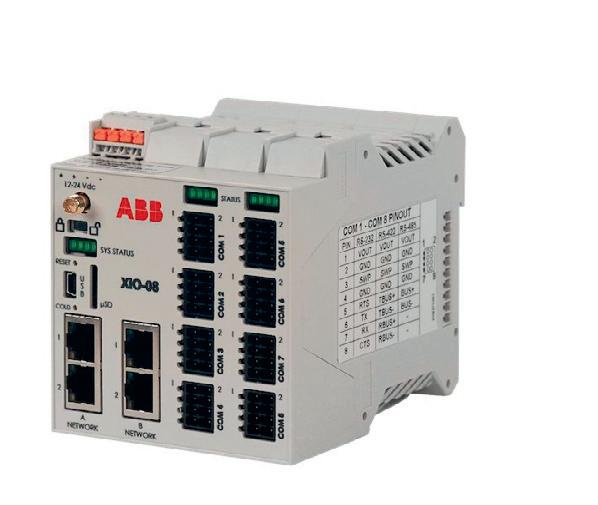
This XIO extension means that site configuration requirements can be met whatever the size of the oil or gas field. The need for physical onsite presence is reduced due to the remote control and monitoring of I/O points and serial devices. As well as extending ABB’s RMC capabilities, the XIO is compatible with a wide range of controllers from other companies.
Equipment can be added without significant infrastructure modifications, allowing easy expansion of I/O points and connection of serial devices. Up to 22 hot pluggable I/O modules can be added or replaced without power interruption.
The XIO series offers several connectivity options, new networking features (up to four independent networks are supported) and the possibility to use the XIO’s Wi-Fi as a network or bridge with one of the Ethernet ports.
As a specific integration feature, ABB’s RMC discovers an XIO device on the network and learns its configuration, becoming a consumer of the XIO’s application data without the need to maintain a list of connected devices.
ABB Australia Pty Ltd
www.abbaustralia.com.au
30 PROCESS TECHNOLOGY - AUGUST/SEPTEMBER 2023 www.ProcessOnline.com.au NEW PRODUCTS
ED HUSIC TO OPEN MODERN MANUFACTURING EXPO 2023

The Modern Manufacturing Expo 2023, taking place from 20–21 September at the Sydney Showgrounds, will be opened by the Minister for Science and Industry, Ed Husic.

“Minister Husic has been an outspoken advocate for enhancing Australia’s manufacturing capabilities and his presence at the 2023 Modern Manufacturing Expo is set to be hugely valuable for attendees,” said Marie Kinsella, CEO of the International Exhibition & Conference (IEC) Group, organisers of the expo.
The minister will give the opening address at the Smart Manufacturing Conference on Day 1 of the expo (Wednesday, 20 September) at 9:15 am. His address will focus on the government’s vision to rebuild manufacturing and sovereign capability, exploring new technologies for Australian manufacturers and future opportunities from the National Reconstruction Fund.
“The Smart Manufacturing Conference is a paid-for event that forms part of the larger, free-to-attend Modern Manufacturing Expo and features a world-class program of internationally known manufacturing companies,” Kinsella added. “We trust that Minister Husic’s participation will be incentive for attendees to register and embrace the future of connected, automated and digital automation.”
Following his opening address at the Smart Manufacturing Conference, Minister Husic will officially open the 2023 Modern Manufacturing Expo in the Expert Arena, on the show floor from 9:50 am.
The $15 billion National Reconstruction Fund allocated $1 billion to the advanced manufacturing sector, with a further $1.5 billion for medical manufacturing and $1 billion for investment in critical technologies such as AI and robotics, both of which form a core part of advanced manufacturing.

To ensure that the funding is allocated as efficiently as possible, the government will work closely with industry to develop coinvestment plans that identify high-level investment opportunities in the manufacturing sector.
Opportunities for local manufacturers in the form of resources and funding will be discussed in depth at the expo.
What: Modern Manufacturing Expo
When: 20-21 September 2023
Where: Sydney Showgrounds, Sydney Olympic Park Web: https://modernmanufacturingexpo.com/
The Best Move – Safety First
www.turck.com/da-safety
AUGUST/SEPTEMBER 2023 - PROCESS TECHNOLOGY 31 www.ProcessOnline.com.au
LEARN MORE
Decentralized safety systems place personal protection close to the danger points and create levels of freedom for modular production.
VALVE ACTUATOR WITH APP INTEGRATION
Rotork has introduced the IQ3 Pro valve actuator with full mobile app integration. The Rotork App provides control and communication capabilities for the IQ3 Pro and is designed to be a handy way to operate and configure the actuators using a smartphone.

The app introduces smart features, including a virtual Rotork Bluetooth Setting Tool (BTST), a valve configuration set-up wizard, which streamlines commissioning, and data logs from the IQ3 Pro actuators can be extracted via the app and exported to Rotork Insight 2 software or sent to Rotork’s cloud-based intelligent asset management (iAM) system.

The app features ‘PIN pairing’ between the actuator and the app to gain access, which ensures the security of the installed actuators. Once logged in, a dashboard shows the actuator details, and users can navigate to all app functions. A virtual setting tool provides full access to the actuator on-screen set-up menus.
The data logs function simplifies the process by allowing flexible download, export and upload.
The IQ3 Pro data logger can record up to 3000 events, providing a comprehensive record of actuator performance. The data log files include torque and operation, temperature, vibration and event log information. Other metrics, such as partial stroke profile, maximum starts per hour and motor run time, are also available.
Rotork Australia
www.rotork.com
COBOT SOFTWARE PLATFORM
FIELDBUS OPTOCOUPLERS
Turck’s FOC series optocouplers are designed for transmitting fieldbus communication via fibre-optic cable. The single- or dual-channel devices of the FOC series transfer fieldbus protocols such as Profibus-DP or Modbus RTU as light signals along fibre-optic cables. The zone 1 IECEx variant of the FOC couplers can be installed in Zone 1 and can transmit intrinsically safe signals in accordance with RS485IS.
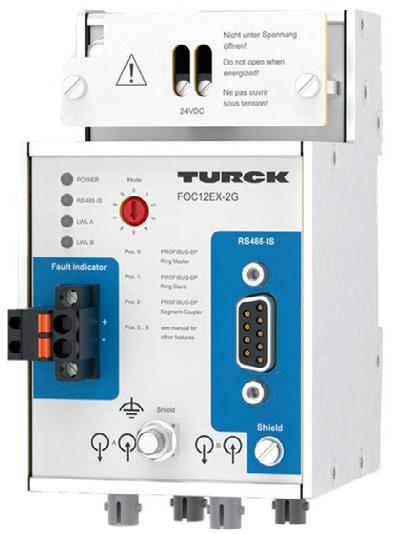
The FOC media converters can cover large distances, more than 2500 m, depending on the fibre-optic cable used. Optical cables are also immune to electromagnetic interference. Users can also configure ring topologies for maximum availability with the devices in addition to point-to-point connections. All devices are provided with a universal shielding concept that can be easily adapted to individual processes. An integrated alarm output of the FOC converters also shortens the time required for troubleshooting.
Turck Australia Pty Ltd
www.turck.com.au
Universal Robots has announced an updated software platform specifically developed for machine tending tasks. Through a customisable user interface, the company says PolyScope X will add new levels of flexibility to high-mix, low-volume machine tending automation.
It is said that shop operators can achieve changeover times of less than 10 min. This will empower users to run more batches in a day and to run them in a more strategic and flexible way. PolyScope X is therefore suitable for high-mix, low-volume production and is introduced at a time when manufacturers all over the world are looking for increased flexibility to handle shifting and increasingly diverse orders.
At the same time, PolyScope X introduces a reworked programming experience and toolset. This enables integrators and OEM partners to structure their program code into operations that can be reused throughout the program, making each operation simpler to understand, maintain and troubleshoot.
PolyScope X for machine tending will initially be available in Germany, the UK and Denmark.
Universal Robots
www.universal-robots.com
32 PROCESS TECHNOLOGY - AUGUST/SEPTEMBER 2023 www.ProcessOnline.com.au NEW PRODUCTS
case study
Greater efficiency with centralised compressed air control
Weidmüller GmbH & Co. KG is a family business that employs 6000 staff across the globe. At the company’s headquarters in Detmold alone, around 2000 employees are responsible for the manufacture and sale of many electrical connection technology products and solutions. In 2022 the electronics specialist generated over €1 billion.
Compressed air is required in the company for assembly processes, as process and control air as well as for electroplating. To this end, Weidmüller installed five separate compressed air networks, each featuring up to seven compressors and other components. The company primarily uses Boge compressors, but also uses air compressors by other manufacturers. The machines cover many performance levels within a pressure range of 7–8 bar. In recent years, the larger networks have been controlled using individual control, while the smaller ones have been controlled via a cascade control using pressure sensors.
Weidmüller recently approached BOGE because they wanted a control system that would incorporate all five compressed air networks and offer a better overview. Other requirements included a reduction in idling and thus increased efficiency. They also wanted to keep operating pressure and power consumption to a minimum.

In addition to the existing BOGE S 150, S 20, S 15 and S 29-2 compressors, there are two S 90-4s, one S 60-3 and one S 40-3 in use, which feature Boge’s focus control 2.0.
“We can read out the temperature, system pressure, network pressure and operating statuses directly at these machines,” said Jens Mühlbauer, project manager at Weidmüller. “This in itself is a huge advantage over older systems, which usually only display information about faults, load and idling as well as on/off.”
In order to meet the requirement of a single control platform, Weidmüller installed Boge’s airtelligence provis 3. The functionality and operation of the interlocking control were first trialled in a field test. This went so well that Weidmüller promptly decided to go ahead with a full installation for all five compressed air networks.
The new control system is backward compatible and integrates all models via Modbus, and via OPC UA offers secure communication with higher-level systems, for example, a control room or energy management system.
The control system is installed on an industrial PC and integrated in a switch cabinet. The individual networks are each connected to the new control system via a single patch cable, and within the network, the
control communications are distributed to the individual compressors via Ethernet switches.
“We provided our own power supply units and Ethernet switches to further boost the signals from the control system,” Mühlbauer said. “The transfer rate is very high and the system is very stable.”
Less compressed air is required at Weidmüller on weekends and on public holidays. The control system regulates this intelligently: it automatically selects the optimal compressor combination and optimises the load and idle times. It can also manage fluctuating compressed air generation in different shifts, and over-compression can be avoided.
Energy management by the airtelligence provis 3 includes setting machine priorities. For example, a 90 kW compressor is connected to take precedence. It supplies Weidmüller’s entire electroplating shop with both compressed air and heat and must therefore run constantly. The whole control was programmed to optimise efficiency by continuously analysing the volumetric flow rate.
Users of the new control system can consolidate maintenance intervals, optimise running and be automatically notified when the integrated machines require maintenance.
“You can always keep your eye on utilisation, the current power consumption and the free air delivery of the individual systems,” Mühlbauer said. “In the past, I had to go to every machine to get the information locally.”
Another advantage has been improved energy efficiency. The electronics company has been able to increase this by 4–5%.
“That’s quite a lot in a system of 450 kW,” Mühlbauer said. “It is a significant improvement compared to systems that run purely via a cascade control or pressure switch not least because the pressure can be reduced on holidays and at night using redefined pressure ranges.”
This can be done minute by minute and for every compressed air network separately, using a few touch commands, without having to laboriously search through the program. The information of the individual networks and compressors can also be displayed on several end devices.
Boge Compressors Ltd
www.boge.net.au
AUGUST/SEPTEMBER 2023 - PROCESS TECHNOLOGY 33 www.ProcessOnline.com.au
Weidmüller has installed five separate compressed air networks for numerous processes in the company, each featuring up to seven compressors and other components.
AS I SEE IT
HOW THE IIoT CAN FAST-TRACK AUSTRALIA’S SOVEREIGN
MANUFACTURING CAPABILITY
The COVID-19 pandemic was a major disruptor across all industries with manufacturing as no exception. Worldwide shutdowns and key transport hub bottlenecks made it clear that Australia needed to place increased emphasis on local rather than global supply chains in order to reinforce our sovereign manufacturing capabilities.
Sovereign capability refers to Australia’s ability to independently exercise control over key areas of interest and strategic importance. This includes the capacity to develop, produce and maintain essential goods, services, technologies or infrastructure without relying heavily on foreign suppliers.
As a cohort of some of Australia’s most prominent automation brands, Open IIoT is strongly invested in exploring how automation and other IIoT technologies can fast-track Australia’s sovereign manufacturing capabilities.

Sovereign capability yields a number of benefits, such as reducing dependence on foreign suppliers. It also makes local manufacturers less vulnerable to potential disruptions in the global supply chain. And, pertinently, it promotes the country’s autonomy and pursuit of national interests.
According to research from Flinders University, manufacturing provides the requisite productive capabilities to all other sovereign goals:
• Value-adding to Australian raw materials.
• Sustainable energy technologies.

• Processing advanced materials for the future economy.
• Critical inputs for other sectors (mining and energy, defence).
• Making pharmaceuticals and medical devices.
However, while manufacturing is integral to the quest for sovereign capability in Australia, our local manufacturing capabilities are limited due to a historical overreliance on global suppliers.
Unfortunately, Australia faces significant challenges in developing the sovereign capability of
Jim
manufacturing due to the high cost of labour, real estate and the raw materials necessary for production within the country. This is where IoT technologies such as factory automation come in, and although this requires a significant initial investment it reduces the costs of labour and even raw materials in the long run.
The primary benefit of using automation to enhance sovereign capability is increased productivity and efficiency. By automating repetitive tasks and streamlining processes, companies can produce goods more quickly, consistently and at a lower cost. Increased productivity enables domestic manufacturers to compete globally, reducing their dependence on foreign suppliers.
Secondly, automation lowers the cost of production and reduces the wastage of raw materials due to increased precision and quality control. By reducing defects and variations, manufacturers can meet higher quality standards and gain an edge over foreign competitors, as well as reduce costs.
It’s important to note that if Australia wants to truly capitalise on the opportunities presented by automation and other IoT technologies to enhance sovereign capability, there needs to be a dedicated effort between both the private and public sectors to enhance our resources and skills. The government will need to allocate resources to support R&D efforts in the manufacturing sector, including funding research institutions to drive innovation and develop new technologies. Infrastructure support is also crucial through the provision of physical buildings where this development can take place.
Ultimately, developing sovereign capability in Australia’s manufacturing sector requires a comprehensive and coordinated effort involving government support, private sector involvement and a long-term strategic vision to foster innovation, skills development, infrastructure and favourable policies.
Westwick-Farrow Media
A.B.N. 22 152 305 336 www.wfmedia.com.au
Head Office Unit 7, 6-8 Byfield Street, North Ryde Locked Bag 2226, North Ryde BC NSW 1670 AUSTRALIA ph: +61 2 9168 2500
Editor Glenn Johnson pt@wfmedia.com.au
Acting Publishing Director/MD Janice Williams
Art Director/Production Manager Julie Wright
Art/Production
Linda Klobusiak, Marija Tutkovska
Circulation
Dianna Alberry circulation@wfmedia.com.au
Copy Control
Mitchie Mullins copy@wfmedia.com.au
Advertising Sales
Sandra Romanin – 0414 558 464 sromanin@wfmedia.com.au
Tim Thompson – 0421 623 958 tthompson@wfmedia.com.au
If you have any queries regarding our privacy policy please email privacy@wfmedia.com.au
Contact the editor
advised by the publishers to ensure that all necessary safety devices and precautions are installed and safe working procedures adopted before the use of any equipment found or purchased through the information we provide. Further, all performance criteria was provided by the representative company concerned and any dispute should be referred to them.
Information indicating that products are made in Australia or New Zealand is supplied by the source company. Westwick Farrow P/L does not quantify the amount of local content or the accuracy of the statement made by the source.
34 PROCESS TECHNOLOGY - AUGUST/SEPTEMBER 2023 www.ProcessOnline.com.au
Wallace is the Sales Director of Balluff Australia & New Zealand and a member of the Open IIoT cohort. He regularly features on Open IIoT’s Industry 4.0 And Beyond Podcast, available on Spotify and on the Open IIoT website.
Printed and bound by Bluestar Print Print Post Approved PP100007403
No. 0819-5447 All material published in this magazine is published in good faith and every care is taken to accurately relay information provided to us. Readers are
ISSN











www.WFMedia.com.au/subscribe FREE to industry and business professionals The magazine you are reading is just one of 11 published by Westwick-Farrow Media. To receive your free subscription (magazine and eNewsletter), visit the link below.
80%* energy savings with Kick and Drop Technology


*individual results may vary
Discover why manufacturers prefer to partner with us >
//













































 Emerson Automation Solutions
Emerson Automation Solutions






























































